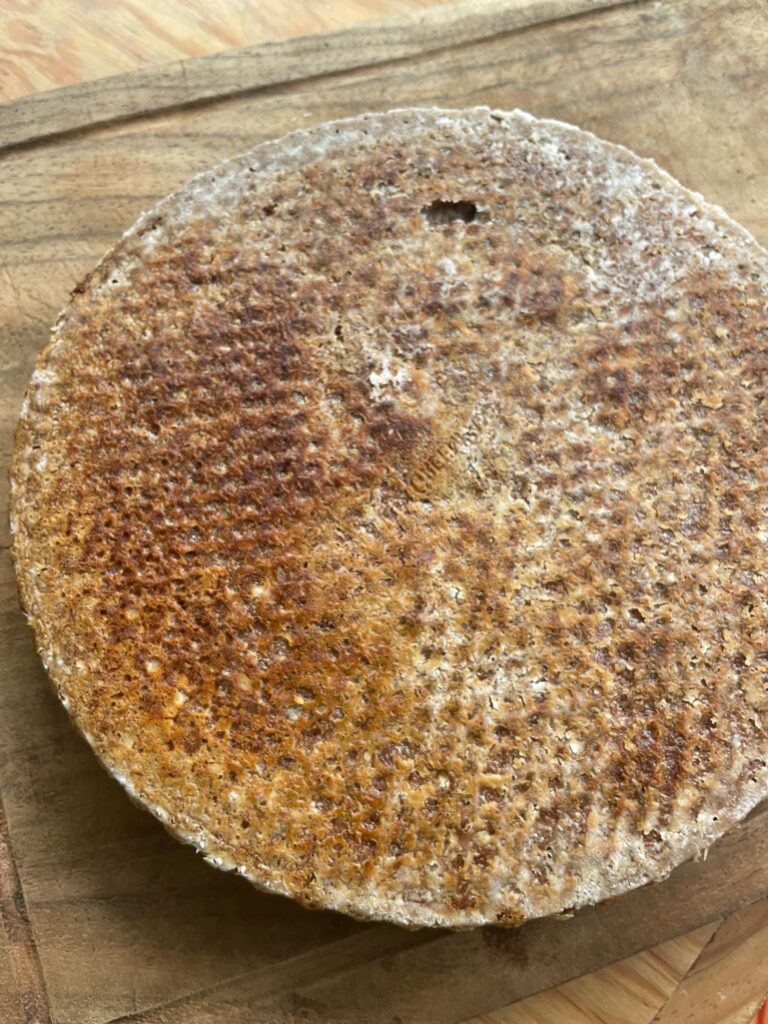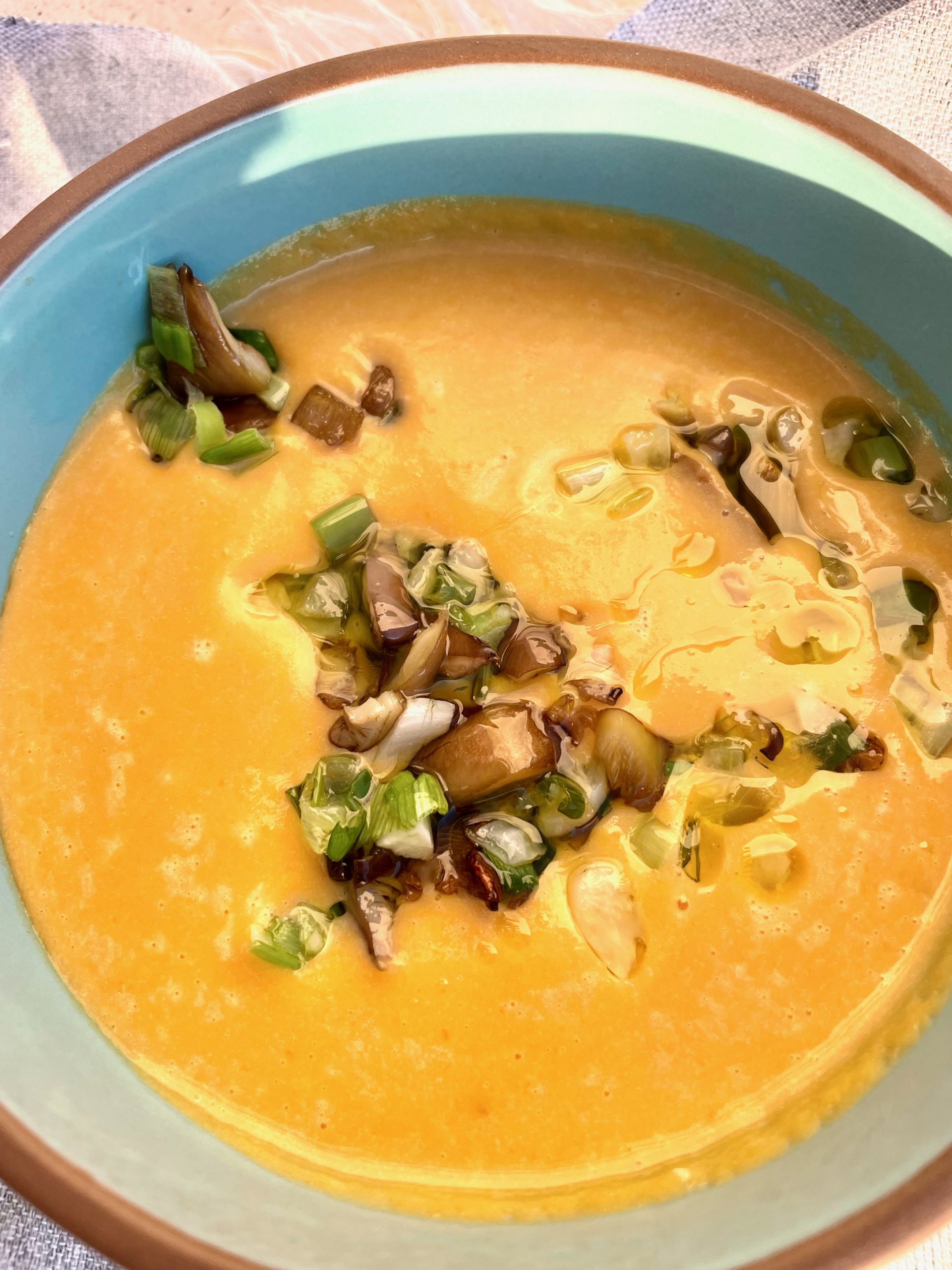Vegan Quinoa Bread is gluten-free
Of course this bread is gluten-free. Quinoa is one of the many gluten free grains, along with rice, amaranth, teff, sorghum, and brown rice. These other grains, along with garbanzo bean flour provides the high protein and nutrient rich bread the post shows you how to make.
Feeding the family bread all weekend: 1 minute on Thursday night for vegan quinoa bread on Saturday.
This quinoa loaf is best served with soup, this crusty bread is baked in a 8 by 12 pan and is cut in generous squares. Crusty and perfect for dipping or buttering up with ghee or coconut oil. If you like the southern tradition of bread or biscuits with a meal, but cannot be bothered with kneading and forming the perfect loaf, this simple bread takes minutes to prepare. Note that the fermentation process of this bread requires you to start it 3 days ahead of time, but each step is mere minutes. Surely you can throw some quinoa in water to soak on Thursday night, so Saturday you have to only devote 10 minutes to a huge tray of bread that is big enough to feed the family through the weekend, or until the end of the next week if your family is one or two. If you are having friends over, or little children, this is the perfect healthy treat. Every child, no matter how picky, loves fresh made bread and nothing could be more affordable and easier. Plus the high protein and vitamin content in this bread nourishes you and your children. If you want bread made on Monday to start the week, start soaking your quinoa on Saturday night before bed.
Note that you can also use cooked leftover quinoa in this recipe and skip day 1, the result will be a softer dough with no perceptible crunch or grain, perhaps preferred by children making a transition to whole grains.
Prep Time: 3 days
Day 1: Soak quinoa overnight in filtered water
Day 2: 15 minutes active prep time
Day 3: 10 minutes active prep time plus 1 hr rise time, and up to 1 hr bake time
Day 2 Instructions: Making your fermented doughs for your quinoa loaf
Mix Separately:
Soaker:
4 oz of whole grain gf flour mix
12 oz quinoa, soaked overnight in water
1 t salt
1 1/2 c water
Biga:
3 1/2 c whole wheat flour blend (16 oz)
1/2 t instant yeast (1 g)
1 1/2 c water (6 oz)
Day 3 Instructions: Final Dough and Baking Day for Vegan Quinoa Bread
Final Dough:
4 oz teff flour
2 T brown sugar
2 T coconut oil
2 T yeast
Biga
Soaker
Whole Wheat Flour Mix
12 oz teff flour
12 oz tapioca
12 oz sorghum
12 oz brown rice flour
12 oz garbanzo flour
Mix all the ingredients of the final dough. Place into a loaf pan that is super greased with coconut oil and dust with tapioca flour. Pour the dough in the pan. After mixing all the parts of the dough it must go immediately in the pan or you will interfere with the rising and formation of the structure.
Cover with a dish towel and let rise for 30-50 minutes until it reaches the edge of the pan. Rise time is extremely dependent on a number of factors. If it looks like it is rising very rapidly, place in the fridge to finish rising. It may take 1.5 hrs to rise in the fridge.
Preheat your oven to around 450-500, as hot as it will get. Pour at 1 quart of water into a pan and place water in the bottom rack of the oven when you start preheating. When your dough is ready, add it to the oven. Make sure water stays in your pan, but not too much because if you suddenly add lots of cold water to the pan it will take a while to start making steam, which is the goal.
When you add the bread to the oven, turn the temperature to 230 degrees Celsius or about 450 degrees Fahrenheit. Check your quinoa loaf after 20 minutes, then at 10 more minutes, and if not done after another 5-7 minutes. The dough should sound hollow in the inside when you tap it with your fingers. If it browns too quickly, turn the oven to 350 F to continue baking the rest of the way.
Check out the Italian Pasta Soup Recipe (GF) and Day 3 of this bread:
Single Quinoa Loaf
If you want to make a smaller batch, in a 8 by 8 in pan, try these proportions:
Soaker:
2 oz of whole grain gf flour mix
1 1/3 c cooked quinoa or raw quinoa*
1/2 t salt
3/4 c water
Biga:
1 3/4 c whole wheat flour blend (8 oz)
1/4 t instant yeast (1 g)
3/4 c water (6 oz)
Final Dough
4 1/2 T teff flour
tiny tiny pinch salt
1 T yeast
1 T coconut oil
Biga
Soaker
*If you use raw quinoa, the result will have some crunch in the texture. If you use cooked quinoa, the dough will be completely soft and the quinoa grains barely perceptible. Depending on how your dough looks, you may want to use less water in the batch with the cooked quinoa.

Science and Nutrition on Zinc: Quinoa contains high levels of zinc.
There is a reason that quinoa is considered a superfood among vegetarians and vegans. It is high in zinc which is a nutrient that is typically low in vegan and vegetarian diets. Too high levels of zinc are not good as this can cause upset tummies or interfere with the immune system, but generally women, especially those with a vegetarian leaning or vegan diet tend to be low in zinc intake.
Zinc is hugely important in the immune system, which it seems like most people are aware of, but we tend to not discuss zinc in factors such as anti-aging or beauty. But zinc is vital for collagen formation. But do not rush out for a supplement until you read the last section of this blog!
Zinc also plays a huge role in ovulation, this could translate into a phenomena of a cycle that changes length, or ovulation that is delayed (and therefore a delayed period) if you are deficient in zinc. The amount of zinc you are consuming is hugely important in the first stages of forming an egg, implantation, and the first stages of pregnancy. A lack of zinc in a mother’s diet could be the reason she is not getting pregnant. Generally those nutrients that are vital for the beginning stages of fertilization are the most crucial for women whose goal is to become pregnant. Read on for more information on this topic.

Zinc in Fertility, Pregnancy, and Lactation
Zinc plays a large role in functioning of the female reproductive system, impacting everything from ovulation to early fetal development (Garner et al., 2021). Pre-pregnancy zinc intake, especially in the three months leading up to conception, significantly influences various aspects of reproduction. Pre-pregnancy and pregnancy zinc intake affects egg implantation, blastocyte development, embryo formation, placenta development, and the development of the baby’s arms and legs (Shah & Sachdev, 2006; Widasari et al., 2020). Zinc is essential for the proper functioning of sex steroid hormones (zinc finger formation) which play many roles in ovarian function (Garner et al., 2021). Zinc also plays a role in prostaglandin structure and function, which is crucial during childbirth (Favier, 1992). In a nutshell, zinc plays a very large role in the beginning of embryo formation in the transformation of a big group of cells from the egg into a fetus. Because of its role in early development, it is important to have good zinc status before and at conception, just as it is for folate.
Zinc and fetal transport
Zinc levels in maternal blood are directly linked to fetal zinc supply, differing from other nutrients that may be preferentially absorbed by the fetus in cases of maternal scarcity. Zinc levels in the mother’s blood directly affect fetal zinc transport.
Availability, or functional levels of other nutrients can be directly affected by zinc: Folate, Copper, Iron.
Folate, copper, and iron all interplay with zinc in regards to a pregnant mother and her baby. There is a large discussion of folate around pregnancy, but what we do not realize is that if a mother is deficient in zinc, but perhaps getting close to or at the right amount of folate, that she can still have a functional deficiency in folate. Of course, all things are relative and it matters how much you are taking of both. The important thing to be aware is that zinc increases the amount of folate absorbed. So this looks like eating a zinc source such as quinoa, cashews, pumpkin seeds, or oysters along side your beans and greens.
On the other hand too high levels of some minerals can interfere with the uptake of other minerals. If your zinc intake is too high, this can interfere with copper absorption. Copper is vital for pregnant and nursing mothers. And as an interesting tidbit for nursing babies, one reason that cows milk is not good for them is the lack of copper in cows milk.
Too high levels of iron intake, usually which only occurs if you are eating a large amount of animal products, can interfere with uptake and therefore maintaining proper levels of zinc intake.

What levels of zinc are needed for pregnant or lactating women?
Aim to incorporate 7.3 to 13.3 mg of zinc from food sources into your daily diet, and remember that zinc can also enter the body through the respiratory system and skin. An estimated 82% of women worldwide have a zinc deficiency during pregnancy, highlighting the importance of regular consumption of zinc-rich foods like pumpkin seeds, cashews, amaranth, or oysters.
Should I supplement zinc during pregnancy or lactation?
in general, human studies have failed to consistently show benefit of zinc supplementation on prevention of fetal malformation, growth, fetus survival, and time of pregnancy (Shah & Sachdev, 2006), and exceeding your needs can damage your fetus. The only times it would be warranted is in times of war or famine.
Should I supplement with zinc for collagen production?
It is always best to get a supplement from food, especially for those nutrients that are not water soluble (like zinc). It is also preferred to get your zinc from food to avoid overdoses because of the negative effects of excess zinc, and because zinc and iron can compete. What this means if you supplement zinc in too large of amounts you can interfere with iron absorption. And you never want to supplement with iron unless under the supervision of a nutritionist (and a doctor). If you want to read more about iron, check out this post: https://thecarmencooks.com/staging/3924/ironformsandphytates/
The only time you might supplement a few zinc pastels is if you are coming down with a cold or flu and you only supplement for the duration of the illness, and certainly not for more than a week. Another circumstance you might want to supplement is if you have a nutritionist do a nutritional analysis of your food intake and you are chronically low on zinc. And in this case your zinc supplement should be less than the RDA for your demographic.
Scientific References for Data on Fertility and Zinc Science
Garner, T. B., et al. (2021). “Role of zinc in female reproduction.” Biology of reproduction 104(5): 976-994.
Shah, D. and H. Sachdev (2006). “Zinc deficiency in pregnancy and fetal outcome.” Nutrition reviews 64(1): 15-30.
Widasari, L., et al. (2020). “The role of multimicronutrients on improving better pregnancy outcomes: A literature review.” A multifaceted review journal in the field of pharmacy.
Garner, T. B., et al. (2021). “Role of zinc in female reproduction.” Biology of reproduction 104(5): 976-994.







